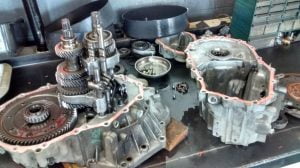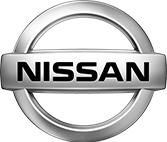Automatic transmissions consist of wearable components and will eventually need a rebuild or replacement. Good vehicle maintenance, however, can extend the central component of your drivetrain. To prevent premature failure of an automatic transmission, we recommend adopting the Ten Transmission Commandments.
1. Maintain the Cooling System
A transmission has hundreds of moving parts and generates a tremendous amount of heat. In fact, the most common cause of transmission failure is overheating. A key responsibility of transmission fluid is to manage that dangerous heat. Even though transmission fluid has become increasingly complex, the best transmission fluids still need assistance. The vehicle’s cooling system provides that help.
The radiator and/or external cooler are both designed to accept hot transmission fluid and cool it before sending it back to the transmission. Like most components in a vehicle, a cooling system should be periodically inspected and maintained. If a radiator is low on fluid, commonly known as antifreeze or coolant, it will not be able to cool the transmission fluid. This will lead to transmission overheating.
Also, the fluid lines to and from the transmission to the radiator need to be periodically checked for leaks. A small leak over time leads to a transmission that is low on fluid. Eventually, there will not be enough fluid to manage the heat generated from the transmission and the unit will overheat.
Finally, a cracked radiator can be disastrous for a transmission. This is a common occurrence in the Nissan Xterra, Nissan Pathfinder, and Nissan Frontier models in certain years between 2000-2010. The radiator is known to develop a crack, causing radiator coolant to enter the transmission lines. Once that coolant and water mixture enters the transmission, a major repair bill is on the horizon. The RE5R05A transmission includes a valve body requiring dealer reprogramming, and the entire job – radiator replacement included – could be north of $6,000. Avoid these types of situations and ensure your cooling system is regularly inspected and maintained.
2. Service the Transmission Regularly
Transmissions do the most complicated work of the vehicle. It only makes sense to service it at regular intervals. A transmission service should include dropping the transmission pan, completing a partial drain of the fluid, replacing the transmission filter, and replacing the gasket to the pan. Between one-third to two-thirds of the original fluid stays in the transmission because fluid from the torque converter does not drain fully in this process. This is ideal for higher mileage vehicles because new fluid is introduced to the system and mixed with the old fluid, minimizing any potential shock to the transmission.
A service should generally occur every 30,000 miles. If a vehicle carries a load, operates in stop-and-go traffic, or travels across dramatic elevation changes, a more frequent service interval is recommended. For lower-mileage vehicles, a Power Flush is a potential solution to add longevity to a transmission in the early life of your vehicle. This is not recommended for vehicles with over 100,000 miles. We suggest consulting your local transmission shop for advice on a proper maintenance schedule based on your geography and the application of your vehicle.
3. Replacing Transmission Fluid with OEM Specified and High-Grade Fluids
There are dozens of transmission fluids, formulated for the hundreds of transmissions on the road. Do not make the terrible assumption that all transmission fluids are the same and then put a generic transmission fluid in your vehicle – it will be a costly mistake! Transmission fluids have specific properties involved in temperate management, clutch engagement, and hydraulic operations, among other responsibilities. Default to the OEM specifications for a fluid type and, if anything, upgrade the fluid.
Low-grade fluids exist on the market, but they are a terrible place to save a few bucks. Upgrading to a fully synthetic fluid or even a premium synthetic is an investment that could decrease the risk of transmission failure and a sidelined vehicle. A transmission specialty shop should be able to provide advice on the best fluid options for your vehicle.
4. Check Fluid Levels Regularly
This should be common sense: if you have a transmission leak, immediately take your vehicle to a transmission specialist or trusted general automotive shop! Also, if your vehicle has a dipstick, check the transmission fluid level every month along with the other major fluids in your vehicle, including power steering fluid, brake fluid, motor oil, radiator fluid, etc. In some cases, a transmission leak only occurs when a vehicle is moving; therefore, it is unlikely to find a puddle on your garage floor. Low fluid level is the most common preventable cause of transmission failure. Even if your vehicle has recently had a transmission fluid service, it is a good idea to check the fluid level yourself.
5. Avoid Excessive Stop-and-Go Traffic
In a prior blog, The Greatest Enemy of a Transmission: TRAFFIC, we highlighted the devastating impact traffic can have on a transmission. Stop-and-go traffic forces a transmission to constantly shift in and out of low gears. Each time the transmission shifts, heat is generated while cooling is inhibited. The air intake at a standstill is constricted, preventing a radiator from cooling the engine and transmission as needed.
Elevation change and a lower concentration of oxygen in the Colorado atmosphere makes traffic even more problematic. This is a daily problem on I-25 going through Denver. You would be just as frustrated driving on I-70 into the Rockies during summer camping or winter skiing season. It is a logjam of traffic, devastating to both your sanity and your transmission.
6. Come to a Complete Stop
Drivers in a rush might reverse out of their driveway or parking spot and engage in drive (D) while the vehicle is still rolling. This will wreak havoc on the gears within a transmission, not to mention the rest of the drivetrain. This bad habit is characteristic of impatient drivers who will soon find themselves in a transmission repair shop. It is best to reach a complete stop and then only switch between forward and reverse gears.
In Colorado, this issue becomes a widespread problem during a snowstorm when drivers get stuck in the snow. To free their stuck vehicle, drivers will switch between “D” and “R” frequently to rock their vehicle into some patch of road that might provide traction for escape. Avoid this habit to maintain the health of your transmission!
7. Maintain the Vehicle
Failure to repair or maintain components within the vehicle can have adverse and unexpected consequences on the transmission. For example, a mass air flow sensor measures the air intake level and, in some cases, the temperature of the air. The sensor has a direct impact on the fuel injection system and a faulty sensor can lead to a disconnect between throttle, engine RPM, and transmission engagement. Countless transmissions have been rebuilt over the years when a bad mass airflow sensor was misdiagnosed as a transmission failure. On the other hand, countless transmissions have eventually become damaged due to faulty sensors that prevent optimal transmission operations.
Engine or transmission mounts are another example. These parts secure an engine and transmission in place to prevent excessive movement while operating a vehicle. Countless transmissions have been misdiagnosed as faulty when mounts are damaged. A bad mount causes a misdiagnosis in the short run and will cause damage to the transmission over time. This is a common problem in vans from Chrysler such as the Caravan and Town & Country models. These vehicles are equipped with 604 or 62TE transmission models, both expensive units to rebuild. Similarly, Toyota Sienna vans have a similar issue with faulty mounts.
8. A Healthy Battery and Clean Electrical System Helps the Transmission
In an automatic transmission, hydraulic and mechanical forces control shifting between gears. By the 1990s, electronics took the lead role in operations. That trend has continued with the increased electrification of the transmission. Although this allows for improved drivability and fuel economy, modern transmissions now rely on a healthy battery and clean electrical system. Corrosion of the battery or a malfunctioning alternator can prevent the transmission from operating correctly. This is a dangerous situation, because symptoms that traditionally lead to a diagnosis of an internal transmission problem may be the result of another component such as the battery, alternator, or wiring harness. No customer or transmission repair shop would want to install a rebuilt or remanufactured transmission with a bill for thousands of dollars only to realize the real culprit was an electrical system that required maintenance or repair for a fraction of the price.
Even worse, the vehicle may have a powertrain control module (PCM) or transmission control module (TCM) that sits with the electronics in the engine bay that is providing erratic shifting commands to the transmission. This may be the cause of a transmission prematurely failing but even with a transmission replacement, the cause of the problem is not resolved. Unfortunately, this is a common occurrence in transmission shops where the diagnosis was correct (needing a transmission), but the transmission replacement did not solve the root problem! To add insult to injury, the replacement of a PCM or TCM is often expensive if the computer is even available.
9. React Quickly to Small Transmission Symptoms
Transmission failure is inevitable as mileage piles onto a vehicle. Even if a perfect maintenance schedule is adhered to, high mileage will eventually take its toll on components such as gaskets, seals, and clutches. These are often categorized as “soft parts” because they deteriorate over time. Recognizing a problem that exists can occur through a fluid inspection, the appearance of a leak, feeling a vibration, or hearing an unfamiliar noise. In some cases, this noise can sound like a howl or whine. It is common for the symptom to be intermittent, and change based on the temperature of the transmission. If the vehicle is shifting as expected but shows one of these symptoms, one would expect the major hard parts to be intact. Yet, in these situations, certain hard parts may be at the end of their lives. Also, don’t play backyard mechanic and assume additives to fix slipping or shuddering are effective. Most transmission specialists will dismiss these products as marketing gimmicks, items that provide customers with a false sense of short-term comfort while their transmission deteriorates. As that’s occurring, their future transmission repair bill rises.
It is more economical to replace soft parts, select electronics, and a torque converter than replacing the countless hard parts within a transmission. Once a transmission with high mileage begins to show the first signs of internal failure, there is a small window to preserve the integrity of most parts within the transmission. Completing a transmission rebuild at this point often means the drums, planetary gears, valve body, pump, shafts, and case can all be cleaned and confidently reused in the reassembly of a rebuilt transmission – a transmission that should perform better than the original OEM transmission. It is expected to operate better because there are upgraded parts that, over time, have been identified to reinforce the weak points of various transmission models. Any quality local transmission shop should know which upgrades are required to address certain vulnerabilities for each common transmission.
10. Avoid Excessive Load
Each vehicle has certain load or weight limitations. Those limitations are not meant to be disregarded unless you deeply yearn for a costly transmission repair bill. Many drivers with cars or small SUVs do not think about this topic; however, it is still relevant. Drivers of trucks and vans are notorious for abusing their vehicles due to overloading or hauling. It is common lingo for truck owners to reference their half-ton, three-quarter-ton, or one-ton pick-up. These designations reflect a truck’s weight classification. If someone hitches a 30-foot trailer with 10,000 pounds of weight to the back of a regular Chevy Silverado or Ford F-150, you can be sure that the transmission will overheat and get damaged prematurely. In contrast, if you hitch that same trailer to the back of a Dodge 3500 with a heavy-duty engine and transmission, it should operate fine if driven and maintained responsibly. It’s important to note that even if you are hauling within the load specifications of your vehicle if it is done regularly, you are likely going to face premature transmission failure and higher overall maintenance costs.
Due to high mileage and excessive loads, most transmission shops across America perform transmission repairs on trucks more than any other vehicle type.
Your Local Transmission Shop
Following the Ten Commandments of Transmission Maintenance will assist in getting a full life out of the critical drivetrain component. When the time does come for transmission repair, trust a transmission specialty shop with a strong reputation over a dealership or general automotive repair facility that may not be familiar with the modern complexities of transmission repair.
If you are in the Denver metro area and want the best transmission repair shops in the region to inspect your vehicle, we recommend you make an appointment at one of our highly-rated Advanced Transmission Center locations immediately. Our technicians can perform our TrueTest Inspection free of charge and let you know if any servicing or repairs are recommended.
Additional Considerations
What specific tools or equipment should car owners have to perform basic transmission maintenance checks at home?
A dipstick for checking fluid levels, a funnel for fluid changes, and a jack with stands for safely raising the vehicle are essential for basic home maintenance tasks.
How do the recommended maintenance tips vary for different climates or driving conditions?
For extreme climates, adjustments in fluid types and change intervals can be crucial. More frequent checks and fluid changes might be necessary in harsh conditions.
Can following these maintenance tips influence the warranty on new vehicles?
Following recommended maintenance schedules is key to keeping your warranty intact. Deviating from these schedules could potentially void your warranty, so it’s essential to adhere to manufacturer guidelines.
You can also reach us directly at the following shop numbers:
Southwest Metro Denver (Lakewood/Littleton): Call (303) 922-4102
Northwest Metro Denver (Westminster): Call (303) 421-4140
We’ve been “Geared for Customer Satisfaction” for 5 decades and we appreciate your trust in our locally owned and locally managed team!
Advanced Transmission Center is a Colorado-owned and operated auto repair shop with locations in Denver / Lakewood and Westminster. ATC specializes in driveline issues such as automatic transmission repair, four wheel drive repair, clutch replacement, differentials, manual transmissions and CVT. As Colorado's first AAA approved shop our goal is to provide accurate, timely service with exceptional customer satisfaction. All of our technicians are certified in the latest makes and models and we are one of the few transmission repair shops with a nationwide warranty.






 Free Customer Towing Service
Free Customer Towing Service  Free TrueTest™ Inspection
Free TrueTest™ Inspection  Fast Transmission Services
Fast Transmission Services  Comprehensive Warranty in Denver
Comprehensive Warranty in Denver 

























